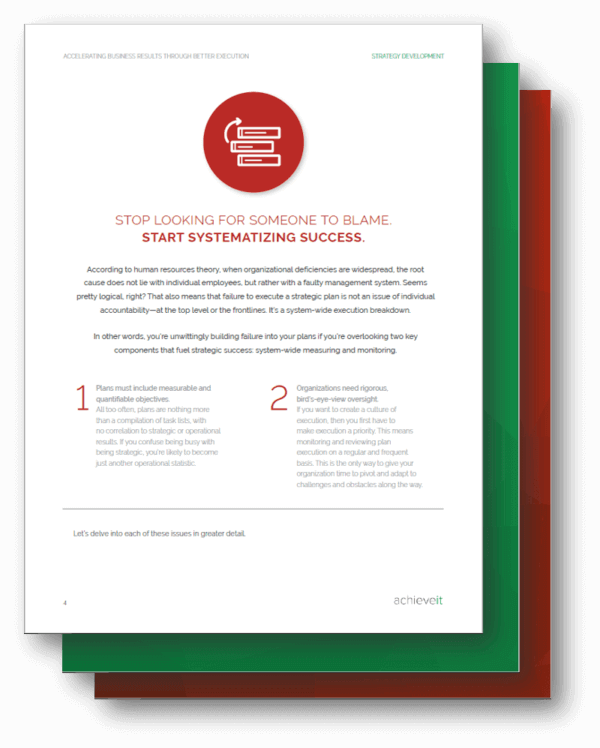Execution is hard. We all know it’s hard. It’s an organizational mindset.
But, in case you need a little extra convincing, here are a few telling statistics:
- Only 10% of organizations surveyed achieve at least two-thirds of their strategic objectives.
- 67% of well-formulated strategies failed due to poor execution.
- 61% of executives say their organization struggles to bridge the gap between strategy formulation and strategic execution.
While these statistics are disheartening, there are best practices you can incorporate when creating and implementing your strategic plan to help stack the odds in your favor.
Create Your Plan
There are 5 key elements you should be sure to incorporate to best position you for success:
1. Alignment. What are we doing and why are we doing it?
Create a sense of purpose and ownership. Align each employees’ activities to your organization’s most important initiatives and measures. Employees should understand why the work they’re doing is important. As well as what strategic outcomes their work is supporting. Make sure it’s structured for actual execution.
2. Quantitative Outcomes. How will we know if we hit the target?
Being very clear about what success looks like improves your chances of success. Create KPIs or metrics that signal whether you are meeting (or not meeting) your goals. A good rule of thumb is to have 20-30% of your plan tracking quantitative metrics.
3. Defined Accountability. Who’s responsible for creating results and reporting progress?
In a lot of cases, there are several people working towards the same goal. But we need to have a single source of accountability to report progress. It avoids confusion and aligns expectations for everyone involved. Hold one person accountable for creating results for an initiative and communicating the status.
4. Start and Due Dates. What’s our timeline?
Create start and due dates for the items within your plan to communicate when items are expected to start and finish. These should be spaced throughout the course of the year or multi-year period. They should make sense for what you are trying to accomplish long term.
Hint: Everything should not start on January 1st and end on December 31st.
5. Cadence of Accountability. How often are we reporting progress?
Collect and discuss progress updates on your plan often. Be sure not to wait until the project or milestone is due before you get updates on how it’s performing. This will allow you to address any roadblocks and cut surprises, as well as boost your accountability.
FREE RESOURCE
Accelerate Business Results Through Better Strategy Execution
Download this guide to understand the key components of effective plan review and monitoring, while creating measurable and quantifiable objectives.

Implement Your Plan
Let Your Plan Live. You don’t always have to stick to the plan… it can change.
You can spend hours, weeks, and months developing a solid strategic plan and it still won’t be perfect. You’re making bets on the future with limited and imperfect information, which means that you won’t always get it right.
Approach your plan as if it were a living document, giving it room to change and evolve with time. This planning process lends itself to a certain level of agility that enables you to shift gears without letting a rigid plan get in the way of progress.
Track Your Progress. Don’t make it cumbersome.
If you aren’t tracking your plan in a streamlined way, it’s likely that you will miss key information. You won’t have a clear picture of how you’re performing.
Tracking progress is an essential part of operationalizing your plan. It’s imperative to have a proper mechanism in place to do so. This will allow you the opportunity to have timely discussions with stakeholders, remove barriers to success, and improve your likelihood of successful strategy execution.
Conduct a Retrospective. Hindsight is 2020.
Conducting a retrospective at the ending of a planning cycle gives you the opportunity to take a look at where you’ve been and what you’ve done as a means to learn and improve.
Ask yourself, “What should we start, stop, and continue?” “What worked and what didn’t work?” “What can we do to execute at a higher level?”
In sum, plan well for what you can, track your progress, and be ready to adapt. This will help stack the odds in your favor as your implement your organization’s strategic plan and successfully execute it.
About AchieveIt
AchieveIt is the platform that large organizations use to get their biggest, most important initiatives out of the boardroom and into reality. Too many great ideas never quite make it across the finish line, because there’s no real way to keep everyone on course and keep everything on track. What does it take to actually guide these initiatives all the way through to completion? You’ve got to:
- Get everything in view – so you can see what’s happening with every initiative, at every level, from the enterprise to the individual, in real time.
- Get everyone engaged – with an easy-to-use platform that connects your organization from the executive leadership to the project teams, keeping everyone accountable and on the same page.
- Get every possible advantage – not only because you have the premier platform in this space, but because you can draw on the experience and best practices of our execution experts.
That’s why everyone from global corporations, to regional healthcare systems, to federal agencies have turned to AchieveIt for their Integrated Plan Management. Let’s actually do this.
Ready to improve your plan execution?
Organizations of all types leverage AchieveIt to manage, execute, and connect their most important initiatives. Replace manual processes & siloed systems with interconnected plans in a single, automated platform.



